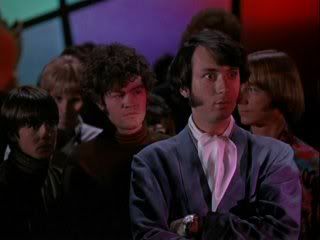The money's in, we're made of tin, we're here to give you more.

It's arguable that the Monkees as a popular phenomenon were already over by the time Head was put before a bewildered public in the fall of 1968, but that doesn't make it any less fascinating a cultural artifact. Directed by Bob Rafelson, who was one of the producers of the TV series, and written by Rafelson and Jack Nicholson (with uncredited input from all four Monkees), Head depicts the group's repeated attempts to "break out of the box" (i.e. television), all of which end up in failure. Individually or as a group, they can't help but fall prey to their personae as codified by two seasons on their eponymous television show.
One scene which exemplifies this is when Davy Jones is getting the stuffing beaten out of him by Sonny Liston in a boxing ring. Micky Dolenz is at ringside, exhorting him to "Stay down, dummy!" but soon enough Peter Tork comes along to correct him. "I'm the dummy, Micky," Tork says. "I'm always the dummy." Extrapolating from that, it's not hard to identify Micky as the lovable goofball, Davy as the cute one and Mike Nesmith as the cynical stoic. Throughout the film, each gets a chance to showcase other sides of their personalities. Micky finds himself in a stand-off with a Coca-Cola machine in the desert. Davy breaks into an elaborate song-and-dance routine (with choreographer Toni Basil). Mike loses his temper at a birthday party. And Peter learns the truth about conceptual reality at the foot of a mystic, but is unable to communicate it to the others.
The film is chock full of bizarre cameos from the likes of Timothy Carey (who they keep bumping into on the backlot), Victor Mature (who first pops up in a dandruff commercial and then keeps popping up) and Frank Zappa (who is leading a cow when he tells Davy to keep working on his music because the song he just performed was "pretty white"). The imagery is frequently psychedelic, the concepts are pretty heady and the transitions are whiplash-inducing, especially as the film progresses and gets more and more self-reflexive. There's even a scene where Peter punches a cafeteria worker and the Rafelson calls cut, but the camera keeps rolling to document the aftermath as Peter expresses his concern about how the scene will affect his non-violent image and Rafelson shrugs him off, consulting with Nicholson before they move on to the next set-up.
And, of course, there are the songs. The most memorable one is the psychedelic "Porpoise Song," which opens the film after Micky disrupts a bridge dedication ceremony, finally leaping to the icy waters below, where he is visited by mermaids. (Some guys have all the luck.) The live performance of "Circle Sky" which follows, though, is just as effective, especially when their fans rush the stage and literally tear the performers to pieces to have something to take home with them. (And before you snicker, yes, the Monkees did learn how to play their own instruments and they did take the show on the road.) It all comes back to "Porpoise Song," though, as the film comes full circle, having spent 80 minutes showing exactly what Micky was running from. For the Monkees, there is no escape.